Cucumbers have practically no monophage pests. They are damaged only by omnivorous insects. They cause the greatest harm to greenhouse cucumbers. The most dangerous pests are spider mites and aphids. We will learn how to effectively deal with them in this article.
| Content:
|
Main pests and ways to combat them
spider mite
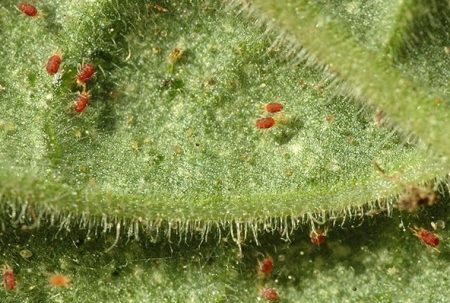
Description of the pest. The pest has microscopic dimensions: 0.25-0.5 mm, almost invisible to the naked eye. The body covers are orange or greenish-yellow, with dark spots on the sides. Females overwinter under plant debris, bark of trees and shrubs, and in manure.
In spring, females settle on young leaves of plants, feed on their juices and lay eggs. More than 10 generations of pests appear during the season. Depending on the temperature, the larva develops in 8-20 days. Both larvae and adult mites live on the undersides of leaves.
Nature of damage.
- The leaves are entangled in a thin web, the skin is pierced and the juice is sucked out of them.
- Grayish-marbled spots remain where the pest feeds.
- Light dots appear on the leaves, which gradually become discolored.
- The leaf turns yellow and dries out.
How to deal with a pest
- Collection and destruction of damaged leaves.
- Before treating plants, remove the cobwebs, as they trap drops of liquid and prevent the drug from contacting the mites and the leaf surface.
- In the initial period of the appearance of the pest, biological products are used: Akarin, Agravertin, Fitoverm, Vertimek, Bitoxibacillin. The effect of the drugs begins after 8-12 hours. For a quick effect, the treatment is carried out on the underside of the sheet.
- Use of acaricides: Apollo, Floromite, Sunmite. Used when cucumbers are severely damaged by a pest. With a single treatment, about 50% of ticks die. Therefore, 3 sprayings are done with an interval of 3-5 days so that the mites do not have time to adapt and give rise to a new generation. Since ticks quickly develop resistance to drugs, each treatment is carried out with a new product.
- Spraying with broad-spectrum insecticides: Karbofos, Sherpa, Inta-Vir.
- When growing cucumbers in greenhouses, the humidity is increased to 90%. Ticks cannot tolerate humid air and die.
Folk methods of struggle.
- Calendula infusion. 400 g of flowers are poured into 1 liter of water and left for 3 days, then diluted in 5 liters of water and processed into cucumbers.
- Onion or garlic peels (200 g) are poured into 10 liters of water and left for 12 hours. Then the solution is filtered and sprayed on the plants.
- 2 tbsp. l. hydrogen peroxide is diluted in 1 liter of water and the cucumbers are sprayed with a freshly prepared solution. The treatment is repeated after 3-5 days.
- Finely chop dandelion greens (500 g), add a bucket of water and leave for 3-4 hours. Then strain and process.
Folk remedies do not so much cause the death of the tick as they repel it. As a result, it can migrate to other crops or weeds.
Preventive measures.
- Disinfection of greenhouses in spring and autumn.
- Mowing weeds around the perimeter of greenhouses and cucumber beds.
- Planting calendula around the perimeter of borage.
- Deep digging of the soil in late autumn.As a result, overwintering pests end up on the surface and die in winter.
Crop rotation does not help with spider mite infestation, since this pest is omnivorous and damages crops planted in place of cucumbers.
melon aphid
Aphids attack cucumbers throughout the summer. In greenhouses, it damages cucumbers in the spring; in open ground, colonies appear in July-August. The pest settles on the underside of leaves, shoots, flowers and ovaries. In early spring, aphids feed on weeds and then move on to crop plants. It spreads the cucumber mosaic virus and fungal diseases of cucumbers. The melon aphid damages all pumpkin crops.
Description of the pest. Aphids are very small insects, 1.1-2 mm long. Color ranges from yellow to almost black. The larvae are yellow or green. The larvae or female founders overwinter on plant debris. When the air temperature warms up to +12°C, aphids begin feeding on weeds and actively reproduce. About 10 generations of pests appear per season.
Nature of damage.
- Aphids damage all above-ground parts of the plant. She pierces the tissues and sucks the juice out of them.
- Leaves lose color, turn yellow, wrinkle, curl and dry out.
- Damaged flowers fall off.
- The scourges wrinkle and dry out.
- The ovaries fall off.
- Fungal diseases begin to develop on the sweet secretions of aphids, especially in the greenhouse.
What will help in the fight against aphids
- If the number of pests is insignificant, treatment is carried out with biological preparations Fitoverm or Actofit.
- For large colonies of aphids, treatment is carried out with insecticides Inta-Vir, Karbofos, Aktara, Iskra.
- All treatments are carried out on the underside of the leaf, since the bulk of the insects are located there.Only a small number of individuals feed on vines and flowers.
All control measures are at the same time a prevention of pest attack. In the spring, greenhouse cucumbers are treated regardless of whether there is a pest or not. At the end of June, ground cucumbers are sprayed for preventive purposes. The melon aphid is very affectionate and, having destroyed one generation, there is no guarantee that it will not appear again. After some time, female dispersers fly to the cucumbers again, so at least 2 sprayings are done during the summer.
Folk remedies.
This is the best way to control the pest. The integument of aphids is very delicate and easily damaged. Therefore, if insect colonies are small, then it is better to use traditional methods of control, which are very effective.
- Treatment of cucumbers on the underside of the leaves with a pink solution of potassium permanganate.
- Finely chop 2-3 kg of tomato tops, add hot water and boil for 30 minutes. Strain the finished broth. For 5 liters of water, 1 liter of decoction; add soap for better adhesion. Process the cucumbers along the underside of the leaves.
An infusion can be prepared from the husk to repel aphids.
- 300 g of onion or garlic peels are poured with a liter of water and left for 24-36 hours. The finished infusion is diluted in 10 liters of water and processed.
- 10 ml of iodine is diluted in 5 liters of water and the cucumbers are treated.
Treatments are carried out in the evening, since during the day in the sun the effect of the drugs is reduced. In cloudy weather, you can spray cucumbers at any time.
Prevention:
- mowing weeds around the borage perimeter;
- attracting ladybugs and lacewings to the site, which feed on aphids;
- autumn and spring disinfection of greenhouses;
- prevent the spread of ants on the site, as they contribute to the active spread of aphids, transferring them to new feeding areas.
Prevention, however, does not greatly protect against the pest, since aphids can fly in from anywhere at any time and the absence of weeds is not an obstacle for them, since there is already a lot of food. Predatory insects will not appear in the absence of food supply (that is, aphids) on the site.
You can read more about how to get rid of aphids here: https://grown-en.tomathouse.com/43/
Naked slugs
They damage all garden crops, especially carrots, cabbage, and strawberries. In rainy weather, the pest can attack cucumbers.
Greenhouse plants are especially susceptible to slugs. The greenhouse has very favorable conditions for them. In open ground, slugs do not attack cucumbers, preferring other crops.
Description of the pest. The pests are 4-12 cm long, do not have a shell, are gray-brown in color, and covered with mucus. Some types have a tapered end. At the front end there are two pairs of tentacles that retract when necessary. The tongue is covered with sharp teeth.
The eggs overwinter under lumps of earth and plant debris. In the spring, young individuals emerge from them and live for 6-7 months. 2 months after hatching from the egg, the pests become sexually mature and begin to reproduce. The female lays 30-50 eggs in the soil.
They feed at night, during the day they hide under lumps of earth, under all kinds of garbage. In cloudy and humid weather it parasitizes around the clock. In hot weather, their activity is low; in the absence of moisture, the pests die.
Fighting slugs
- It is not recommended to use molluscicides in a greenhouse, since the drugs are quite toxic.
- In the greenhouse, be sure to mulch the ground with sawdust, pine needles, and straw.The lower leaves of the cucumbers are removed.
- Removing boards, bricks, loosening the soil. It is necessary to create unfavorable conditions for slugs, then they will not appear.
- When there is a strong spread of pests, the drug Ulicide is applied superficially; it is safer. But this is only if there is no other choice.
- Sprinkle the ground around the lashes with dry mustard, ash, fluff, and tobacco dust. The drugs are not sealed.
- Small grooves filled with eggshells and sand are made along the cucumbers. When trying to get close to cucumbers, slugs scratch the tender abdomen and move on to other plants.
Folk remedies are based on baits and subsequent destruction of the pest.
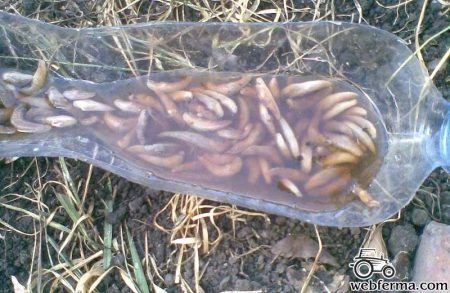
Slug trap.
- Place wet boards and rags in the greenhouse overnight. At night, a large number of pests accumulate under them. They are collected in the morning.
- Spill a bed of cucumbers with an infusion of mustard, hot pepper, and ash.
- Using corn flour. For slugs it is a delicacy, but in large quantities it causes paralysis and death of mollusks. Cornmeal is poured into a jar and placed under the lashes. You can use cornstarch instead of flour.
Prevention consists of daily ventilation of the greenhouse and destruction of weeds around its perimeter.
Read more about how to deal with slugs here: https://grown-en.tomathouse.com/izbavlyaemsya-ot-sliznej/
Woodlice
Sometimes they appear in greenhouses and damage young plants. They are practically never found in open ground.
Description of the pest. Woodlice belongs to the crustacean family. It has a frightening and repulsive appearance. The body of the woodlice is oval-shaped, 1-2 cm long. There are plates on the back, their color is from light to dark gray.When threatened, the woodlouse curls up, turning into a small gray hard lump that is difficult to distinguish on the surface of the soil.
They feed at night on decaying plant remains, but in a greenhouse they can damage crops growing there. They eat the lower leaves, make tunnels in the ground and eat the roots of plants.
During the day they hide under lumps of damp soil and under damaged leaves.
Xnature of damage.
- The pest eats out irregularly shaped cavities and holes on the upper side of the leaf (since it cannot crawl on the lower side) and on the stems. In places of damage, the leaf begins to turn yellow and dry.
- Damaged stems dry out. The pest can completely chew through the whip, then the cucumber dies.
- When it gets to the roots, it eats them away, as a result of which the cucumbers die after 2-4 days.
How to get rid of woodlice
- The main control measures are to reduce soil and air humidity. The pest cannot live not only in dry, but even in insufficiently moist soil. When the soil dries out, woodlice hastily leave the greenhouse, looking for a more humid place.
- Trim the lower leaves as the cucumbers grow. Then the surface of the earth will not be too damp, and therefore woodlice will not appear.
It is highly undesirable to use insecticides on growing cucumbers.
We destroy parasites using traditional methods
- Sprinkle tobacco dust or table salt over the surface of the soil. These substances repel woodlice.
Boric acid for killing woodlice.
- If the pest damages the roots, prepare a solution of boric acid. 20 g of powder is dissolved in 2-3 liters of water and poured onto the soil. Boric acid causes the destruction of the pest's shell, which leads to its death.
- Cut a raw potato or apple in half, make holes in them and place them under the cucumbers in the evening.In the morning, a lot of woodlice will accumulate in them. Wet cabbage leaves are used for the same purpose.
Traditional methods of pest control combined with ventilation and air drying are very effective.
Prevention. The best preventative measures are compliance with agricultural practices. Then the pest will not appear at all.
These are all the most common pests of cucumbers. The most common spider mite found on crops. The melon aphid more often damages cucumbers in the south. In the northern regions it appears on cucumbers less often. Other pests are found in borage only when agricultural practices for cultivating cucumbers are violated.
You might be interested in:
- Cucumber diseases and their treatment
- How to care for cucumbers to get a rich harvest
- What problems may arise when growing cucumbers?
- Growing cucumber seedlings
- Bell pepper diseases and their treatment
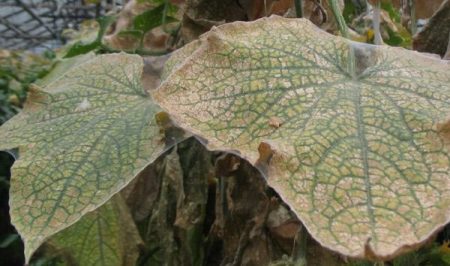
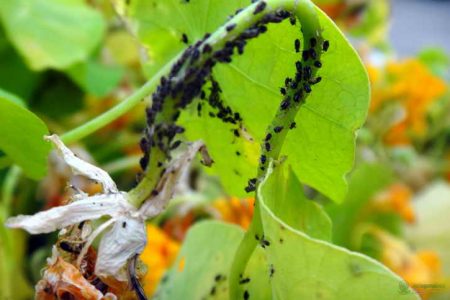
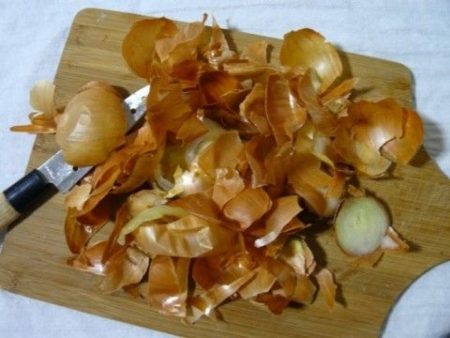
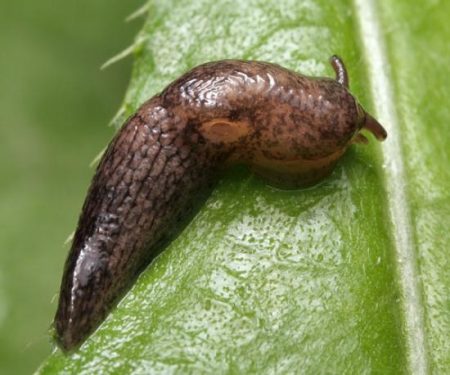
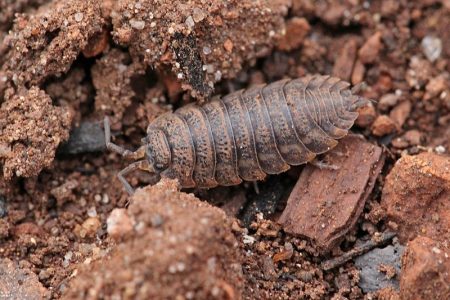
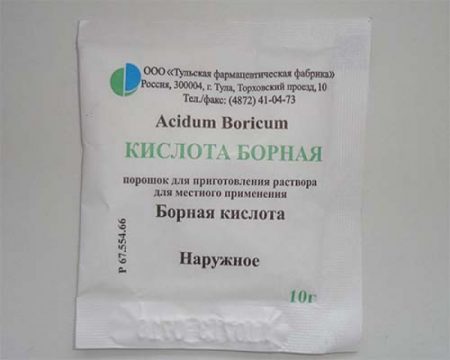

 CUCUMBERS NEVER GET SICK, I'VE BEEN USING ONLY THIS FOR 40 YEARS! I SHARE A SECRET WITH YOU, CUCUMBERS ARE LIKE THE PICTURE!
CUCUMBERS NEVER GET SICK, I'VE BEEN USING ONLY THIS FOR 40 YEARS! I SHARE A SECRET WITH YOU, CUCUMBERS ARE LIKE THE PICTURE! You can dig a bucket of potatoes from each bush. Do you think these are fairy tales? Watch the video
You can dig a bucket of potatoes from each bush. Do you think these are fairy tales? Watch the video
 How our fellow gardeners work in Korea. There is a lot to learn and just fun to watch.
How our fellow gardeners work in Korea. There is a lot to learn and just fun to watch. Eye trainer. The author claims that with daily viewing, vision is restored. They don't charge money for views.
Eye trainer. The author claims that with daily viewing, vision is restored. They don't charge money for views. A 3-ingredient cake recipe in 30 minutes is better than Napoleon. Simple and very tasty.
A 3-ingredient cake recipe in 30 minutes is better than Napoleon. Simple and very tasty. Therapeutic exercises for cervical osteochondrosis. A complete set of exercises.
Therapeutic exercises for cervical osteochondrosis. A complete set of exercises. Which indoor plants match your zodiac sign?
Which indoor plants match your zodiac sign? What about them? Excursion to German dachas.
What about them? Excursion to German dachas.